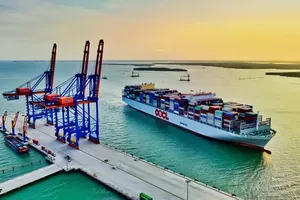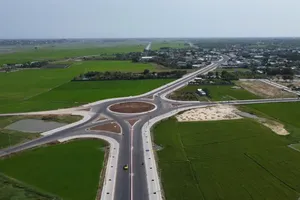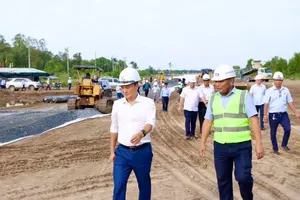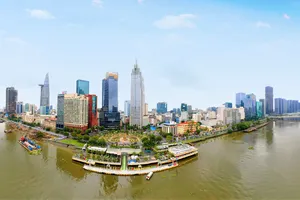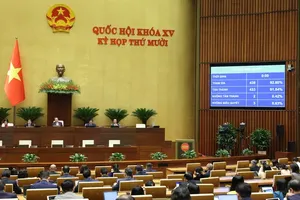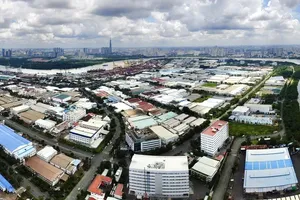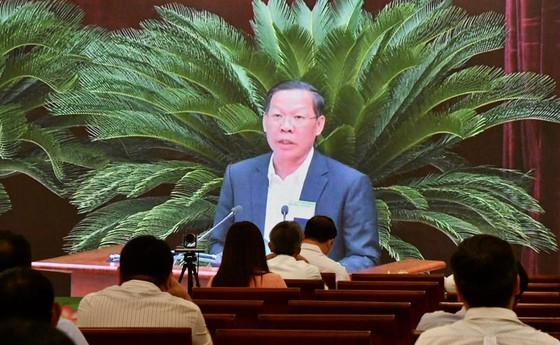 Chairman of the People's Committee of Ho Chi Minh City Phan Van Mai
Chairman of the People's Committee of Ho Chi Minh City Phan Van Mai
The Politburo conference held to carry out the new resolution for the Southeastern region’s socio-economic development, national security, and defense by 2030, with a vision to 2045, was chaired by General Secretary Nguyen Phu Trong.
Co-chairing the conference were President Nguyen Xuan Phuc, Prime Minister Pham Minh Chinh, National Assembly Chairman Vuong Dinh Hue, and permanent member of the Party Central Committee's Secretariat Vo Van Thuong.
According to Chairman Mai, this project is not only meaningful for the benefits of the seaport but also enhances the competitive advantage of the Southeast region in particular and Vietnam in general to the region and the world, creating more attractiveness for FDI inflows.
At the same time, he emphasized that the construction of Can Gio international transshipment port is to maximize the role of seaport cluster No. 4 by taking advantage of the deep water channel at the Can Gio estuary. This project is a complement to the Cai Mep - Thi Vai seaport system, not a competition to weaken the existing seaport system.
This is a basic project using investment capital from domestic and foreign enterprises with high feasibility because the investor is one of the world's leading shipping carriers.
In the current context, the Chairman of Ho Chi Minh City People's Committee believed that if the Can Gio transshipment port project can be implemented, it will not only mean the benefits of the seaport but also enhance the competitive advantage of the Southeastern region in particular and Vietnam in general to the region and the world, creating more attractiveness for FDI inflows.
Ho Chi Minh City also focuses on public investment resources and the mechanism to mobilize social investment resources to implement works and projects on social infrastructure construction and urban embellishment in association with the implementation of the goal of definitively solving problems including flooding, traffic jams as well as the removal of houses on canals and destruction old apartments to build new ones for workers and students.
He assessed that the Resolution 24 of the Politburo is opening up space and development prospects for the Southeast region with many advantages. In particular, the project has been perfecting policies and institutions to create a driving force for the region’s development, not only bringing the region into a new stage of development but also making a great contribution to the process of industrialization and modernization of the country with a vision to 2045. Ho Chi Minh City is determined to implement early and achieve the goals which the Resolution has set out.
According to him, first of all, as per the importance and strategic significance of Resolution 24, coordination between localities in the Southeast region and central ministries is needed to carry out groups of tasks. At the same time, HCMC will strive to achieve the region's overall GRDP growth target of 8 percent-8.5 percent annually in the period 2021-2030 while maintaining the role of the driving economic region. Chairman Mai believed that the above goal is completely feasible with the synchronous implementation of the 6 groups of tasks and solutions set out in Resolution 24.
In particular, the Chairman of Ho Chi Minh City People's Committee emphasized solutions to focus on perfecting institutions and policies and promoting the development of regional linkages with breakthrough significance. At present, the transport infrastructure connecting the region and the regional linkage mechanism, motivational policy and development linkage are the two main bottlenecks, limiting the development of the Southeast region.
The Resolution 24 has pointed out the bottlenecks and the orientation to remove these bottlenecks is very complete and synchronous. However, the Chairman of Ho Chi Minh City People's Committee mentioned the responsibility, first of all, belongs to the Party Committee and local authorities in the Southeastern region to make the implementation of the resolution become true.
He suggested that there should be synchronous and timely coordination between localities in the region and central ministries in implementing specific tasks under Resolution 24 in the Southeastern region.
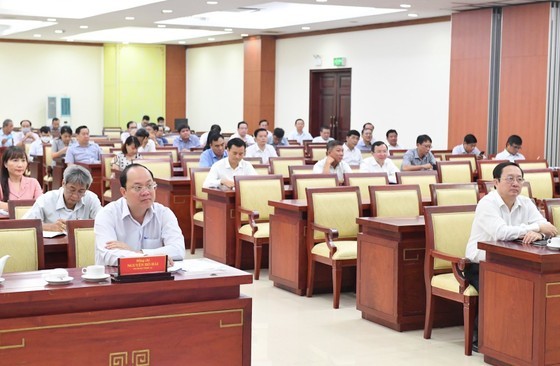 Meeting participants in HCMC
Meeting participants in HCMC
In the immediate future, local administrations should well coordinate in planning work regional planning in addition to the implementation of transport infrastructure projects connecting the region such as ring roads 3 and 4, the highways Ho Chi Minh City - Moc Bai, the HCMC- Chon Thanh, Bien Hoa- Vung Tau and Dong Nai - Lam Dong while expanding Ho Chi Minh City - Long Thanh Expressway.
Last but not least, a railway system connecting urban areas of Ho Chi Minh City should be studied.
With the experience gained from the implementation of the National Assembly’s Resolution 54, Chairman Mai expressed his belief that Ho Chi Minh City will actively coordinate with localities to build, submit to competent authorities for approval and operate the mechanism for regional linkage and coordination.
In addition, the southern largest city also encourages cooperation in transport development, protection of river systems, treatment of industrial waste, domestic and medical waste, and measures to adapt to regional climate change while taking heed of cooperation of developing human resources and building a common database on the region's socio-economic development as a basis for strategic planning, development plans and policies, and coordination of regional linkage activities.
The Chairman of Ho Chi Minh City People's Committee also suggested that there should be a mechanism to expand the cooperation mechanism between the Southeastern region and other regions, especially the Mekong River Delta and the Central Highlands, as well as expand international cooperation.
According to him, in the short term, Ho Chi Minh City focuses on implementing key tasks that both solve the immediate shortcomings and create a foundation for long-term development, in order to continue affirming the city’s position and role in the region. Specifically, the city will restructure the economy after the pandemic, in association with innovating the growth model based on science and technology and high labor productivity and industries towards high technology, green industry for joining in the global production chain and reduce labor-intensive and land-intensive industries
Ho Chi Minh City is focusing on developing the service economy in the direction of developing new services and high-value-added services in association with building an international financial center, an international trade - tourism - logistics center, a digital transformation center, and a regional and international healthcare and human resource training center.
Simultaneously, the city is reviewing the functional transformation of export processing zones and industrial parks towards developing high technology and high-added value associated with the formation of specialized industrial parks on information technology, pharmaceuticals - materials. medical, mechanical, and automation.
Ho Chi Minh City will form innovation centers and modern industrial, service and urban zones. Along with that, the city will pay attention to the development of high-tech agriculture, associated with tourism development, showing more clearly the role of a center for the production of plant and animal varieties and a center for processing and exporting agricultural products.
Ho Chi Minh City gradually realizes the Politburo's viewpoint and vision on the position and role of Ho Chi Minh City in the region as a modern, smart, dynamic and creative city and a place to attract talents.
On the other hand, Ho Chi Minh City asked for the expansion of the decentralized mechanism in some fields such as investment, budget finance, urban-land management, organizational structure, payroll, social management, and a mechanism to attract strategic investors to the international financial center in Ho Chi Minh City in addition to a decentralized mechanism for Thu Duc City.
For the preparation of the inauguration of Long Thanh International Airport phase 1, Ho Chi Minh City is hurriedly building the An Phu intersection, connecting sections of Ring 2. The city is also working with Dong Nai Province to construct bridges connecting District 7, Thu Duc City with Nhon Trach and Long Thanh districts, in order to expand development space in the Eastern gate.
Along with that, the Chairman also proposed to the Ministry of Transport to soon expand the Ho Chi Minh City-Long Thanh-Dau Giay Expressway to Long Thanh Airport. This is a lifeline project to solve traffic problems at Long Thanh Airport.
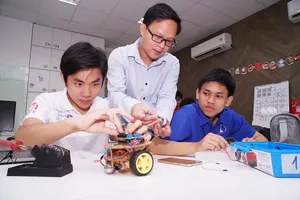
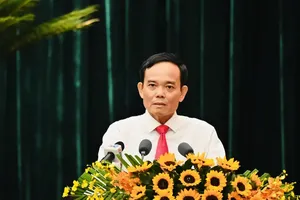
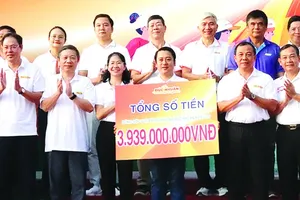
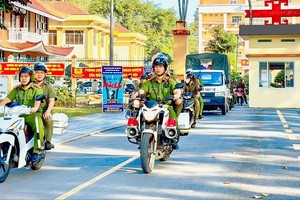
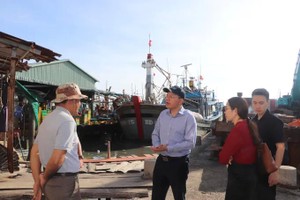
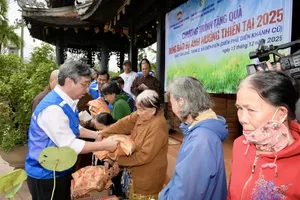

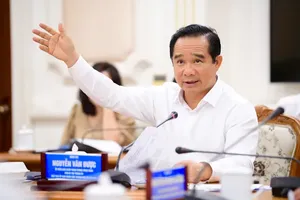
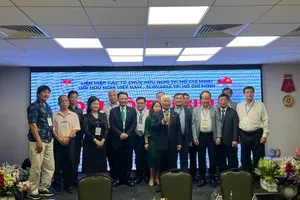

)
